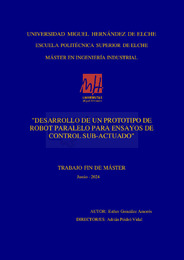Resumen :
En la actualidad, uno de los problemas de los robots paralelos completamente actuados es que, cuando un robot sufre un fallo en una de sus articulaciones el giro de dicha articulación se vuelve libre y el sistema, por consecuencia, sub-actuado. Este fallo, conocido en inglés como Free Swing Joint Failure, FSJF, puede generar problemas importantes, ya que el robot podría oscilar y proporcionar movimientos indeseados que ocasionen problemas de colisiones con otros objetos.
Las soluciones adoptadas habitualmente se basan en el uso de frenos y la adición de más motores, volviendo al sistema redundante, ya que se usarían más de los necesarios. Además de utilizar más elementos de los necesarios, también se encarece el sistema.
Siguiendo el método propuesto en el artículo “Peidró et al. (2023), Mechanism and Machine Theory, vol 188, 105403” se propone que, cuando ocurra la falla se lleve cada elemento a posiciones seguras. Estas posiciones serán las llamadas configuraciones de bloqueo durante la memoria y vendrán calculadas por el método de la nueva solución propuesta en artículo.
Por lo tanto, en la presente memoria se diseñará, realizará, ensamblará y programará un robot que estudia una nueva solución al problema de FSJF citado anteriormente. El robot está diseñado originalmente en un artículo científico que se puede encontrar en las referencias de la memoria. El prototipo se basa en original del artículo, pero no se representa fielmente debido a que, para facilitar su implementación física, se tuvieron que añadir dos offsets que varían ligeramente la cinemática del robot, aunque no lo suficiente como para no aplicar el método de forma muy similar a como se realiza en el citado artículo.
Finalmente, durante la memoria se detalla el proceso de montaje del prototipo del robot y la conducción de las articulaciones a las configuraciones de bloqueos calculadas por el método del artículo.
Nowadays, one of the main problems with fully actuated parallel robots is when a robot experiences a failure in one of its joints, the rotation of this joint becomes free, resulting in a underactuated system. This failure can lead to significant issues, as the robot oscillating and making unintended movements, which could result in collisions with nearby objects.
The commonly adopted solutions typically rely on the use of brakes and the addition of more motors, making the system redundant by using more components tan necessary. In addition, this also increases the cost of the system.
Following the method proposed in the article "Peidró et al. (2023), Mechanism and Machine Theory, vol 188, 105403", it is proposed that when a failure occurs, each element should be brought to safe positions. These positions, termed locking configurations in the article, are calculated using the new solution method proposed in the article. It is noteworthy that this new solution does not require brakes or additional motors.
Therefore, in this report, a robot will be designed, built, assembled, and programed to explore a new solution to the aforementioned free swing joint failure problem. The robot is originally designed in a scientific article referenced in this report. The prototype is based on the original design from the article, but it is not represented exactly, as two offsets were added to facilitate its physical implementation. These offsets slightly modify the robot's kinematics, but the method will be able to aply in a manner very similar to the cited article.
Finally, this report details the process of assembling the robot prototype and guiding the joints to the locking configurations calculated by the method described in the article.
|
 La licencia se describe como: Atribución-NonComercial-NoDerivada 4.0 Internacional.
La licencia se describe como: Atribución-NonComercial-NoDerivada 4.0 Internacional.
.png)
